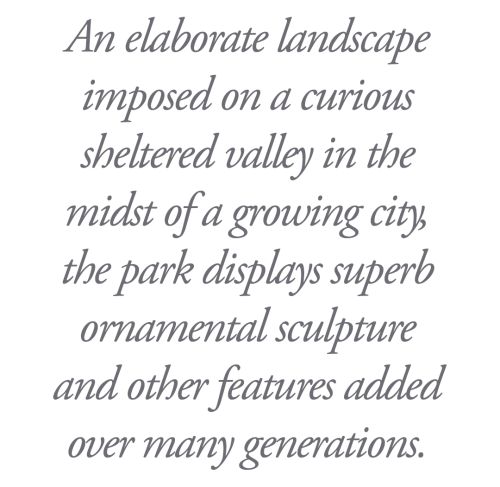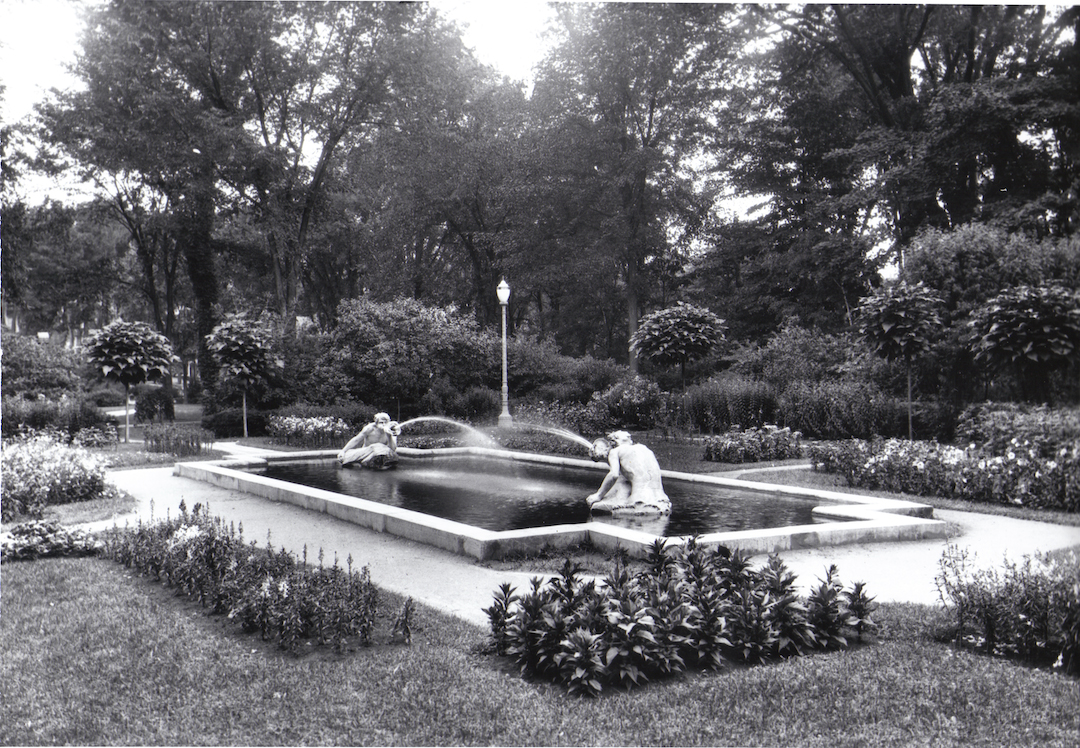Articles
Congress Park
Photo courtesy of the Saratoga Springs History Museum.

Congress Park, the city’s 33-acre public “pleasure garden,” has a surprising origin. It was created by Dr. John Clarke, owner of the Congress Spring, so that visitors would have a pleasant place to “walk off” the laxative effects of the mineral waters.
According to tradition, Congress Spring was discovered in 1792, and was soon popular as an alternative to the High Rock Spring, adjacent to the present Farmers’ Market on High Rock Avenue, which had been in use since before the Revolutionary War.
The waters Gilman found bubbled up in what was then a swamp surrounded by a gloomy pine forest. For many years, improvements were limited to simple platforms, railings, and perhaps an awning. It wasn’t until 1826 that Dr. John Clarke, who had begun bottling the water, acquired the land. Three years later, he built the first promenade, a path from the spring to the Circular Street hill, so visitors could enjoy “a healthful exercise in connexion with a morning visit at the fountain.”
By the mid-1830s, a Greek Revival pavilion sheltered Congress Spring and a smaller classical dome covered the nearby Columbian Spring, but other improvements took place slowly in the privately-owned park, then only on the south side of East Congress Street (now the dead-end street in the center of Congress Park). One of the first amusements was the Circular Railway with its handcranked rail cars, which was in operation during the 1835 season, just three years after the first real railroad train arrived in Saratoga Springs. It wasn’t until 1850 that the last of the swampy areas were drained for lawns and “Congress Spring Park” was in full use.
The country’s centennial celebration of 1876 was the occasion for the park’s first complete redesign. In July 1875 the Congress and Empire Spring Company, which then owned the spring, the park, and an adjacent bottling plant, engaged famed landscape architect Frederick Law Olmsted (who designed Central Park in New York City) to create a unified design. Through these efforts the south half of the present park was graded and landscaped in time for the centennial, and elaborate High Victorian Gothic pavilions, full of rich stained glass, replaced the simple old pavilions and other structures.
During all this time, the north side of the present park was built up with streets and buildings, in particular the huge Congress Hall, a hotel begun in 1812 (and rebuilt in 1867-68) at the corner of Broadway and Spring Street. In 1870-71, prize fighter and gambling promoter John Morrissey built his “Club House” (now Canfield Casino). Private houses, stables, and other structures filled the space between it and Congress Hall. An Indian Encampment, an amusement staffed by mixed-race Indians from Canada, was near Circular Street. Julius Mangelsdorf’s little carousel lured children (and jockeys!) where Union Avenue currently ends at Circular Street.
Morrissey’s “Club House” did not allow locals or women and high rollers went to private gambling rooms on the second floor.
Richard Canfield, Morrissey’s successor, was responsible for the next major landscaping project. In 1901, he built the Italian Garden on his private land along Spring Street. But times were changing, and Canfield’s operation closed in 1907, victim of the broad social reform movement of the era.

Between 1911 and 1913, the village purchased Congress Spring Park, the Casino and its grounds, and the Congress Hall hotel. East Congress Street was blocked at Circular to become a dead end; Congress Hall and the elaborate Vaux and Withers pavilions were demolished, and Charles W. Leavitt of New York City drew a new landscape plan.
Saratogians took great pride in their new park, and contributed to its embellishment. Katrina Trask hired Daniel Chester French to design “The Spirit of Life” (1914-15) as a memorial to her husband. She was later honored by an elaborate stone stairway constructed in 1922. The Brackett Memorial Gateway at the park’s entrance was added in 1914 and, in 1931, the American Legion built the War Memorial Bandstand, replacing a wooden, Victorian bandstand.
But routine park maintenance was subject to the vagaries of city budgets. By the 1950s, although all the major features were intact, the park was showing its age. Saratoga’s last two behemoth hotels had come down in 1944 and 1953. In August 1955, Mayor Addison Mallery began discussions with a New York syndicate that planned to build a 300-room hotel in the park. But “by the time the shouting was all over and the last vote counted, the men with the money had disappeared,” wrote Charles W. Andrews in an article published December 21, 1959, in the Schenectady Gazette.
Another hotel in the park attempt surfaced in 1968 when Dutch Inns of America indicated interest. Fortunately, the City Council was saved from a “dilemma” when the developer withdrew.
As the 1970s dawned, Saratogians could take pride in having protected their park from commercial development. With the election of Tom McTygue as Commissioner of Public Works in 1971, Congress Park gained a champion. For 32 years, McTygue marshaled the resources of his department to address the park’s needs, beginning with the ambitious reconstruction of a Greek Revival pavilion over Congress Spring, initiated by the Historical Society of Saratoga Springs and funded in part by the Saratoga Springs Rotary Club; it was completed and the spring was retubed in 1976. As with many subsequent projects under McTygue’s watch, the use of Department of Public Works labor cut costs in half.
In 1977, the local landscape architectural firm of Leaver, Anthony, Gerow and Associates prepared a master plan for the park. Craftsmen employed by the DPW began repairing the damage of vandals and aging that the report had identified. A perennial problem was flooding of the Village Brook, which runs east to west through the park. When it overflowed, much of Congress Park was inundated. Federal funds secured by the city in 1979 paid for construction of a huge culvert to carry off the water during the heaviest of rainfalls.
In 1987 when Kaydeross Park, an amusement facility at Saratoga Lake, was being dismantled. Saratogians raised more than $131,000 in just 16 days to purchase its Marcus Illions carousel. Housed in a graceful pavilion designed by local architect John Muse, the carousel opened in 2002.
An elaborate landscape imposed on a curious sheltered valley in the midst of a growing city, the park displays superb ornamental sculpture and other features added over many generations.
